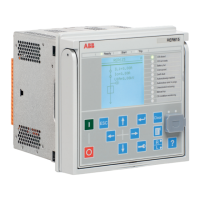Directional calculation
The directional calculation compares the current phasors to the polarizing phasor.
A suitable polarization quantity can be selected from the different polarization
quantities, which are the positive sequence voltage, negative sequence voltage,
self-polarizing (faulted) voltage and cross-polarizing voltages (healthy voltages).
The polarizing method is defined with the
Pol quantity
setting.
Table 256: Polarizing quantities
Polarizing quantity Description
Pos. seq. volt Positive sequence voltage
Neg. seq. volt Negative sequence voltage
Self pol Self polarization
Cross pol Cross polarization
The directional operation can be selected with the
Directional mode
setting. The
user can select either "Non-directional", "Forward" or "Reverse" operation. By setting
the value of
Allow Non Dir
to "True", the non-directional operation is allowed when
the directional information is invalid.
The
Characteristic angle
setting is used to turn the directional characteristic. The
value of
Characteristic angle
should be chosen in such a way that all the faults
in the operating direction are seen in the operating zone and all the faults in the
opposite direction are seen in the non-operating zone. The value of
Characteristic
angle
depends on the network configuration.
Reliable operation requires both the operating and polarizing quantities to exceed
certain minimum amplitude levels. The minimum amplitude level for the operating
quantity (current) is set with the
Min operate current
setting. The minimum
amplitude level for the polarizing quantity (voltage) is set with the
Min operate
voltage
setting. If the amplitude level of the operating quantity or polarizing
quantity is below the set level, the direction information of the corresponding phase
is set to "Unknown".
The polarizing quantity validity can remain valid even if the amplitude of the
polarizing quantity falls below the value of the
Min operate voltage
setting. In this
case, the directional information is provided by a special memory function for a
time defined with the
Voltage Mem time
setting.
(F)DPHxPDOC is provided with a memory function to secure a reliable and correct
directional protection relay operation in case of a close short circuit or an earth
fault characterized by an extremely low voltage. At sudden loss of the polarization
quantity, the angle difference is calculated on the basis of a fictive voltage. The
fictive voltage is calculated using the positive phase sequence voltage measured
before the fault occurred, assuming that the voltage is not affected by the fault.
The memory function enables the function to operate up to a maximum of three
seconds after a total loss of voltage. This time can be set with the
Voltage Mem
time
setting. The voltage memory cannot be used for the "Negative sequence
voltage" polarization because it is not possible to substitute the positive sequence
voltage for negative sequence voltage without knowing the network unsymmetry
level. This is the reason why the fictive voltage angle and corresponding direction
information are frozen immediately for this polarization mode when the need for
a voltage memory arises and these are kept frozen until the time set with
Voltage
Mem time
elapses.
Protection functions
1MRS758755 C
238 REC615 & RER615
Technical Manual

